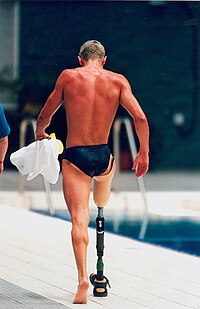
Photo from wikipedia
Background Previous studies have reported that movement-based computer gaming is more effective than conventional intervention in enhancing upper limb rehabilitation. Objective To evaluate whether the use of bilateral movement-based computer… Click to show full abstract
Background Previous studies have reported that movement-based computer gaming is more effective than conventional intervention in enhancing upper limb rehabilitation. Objective To evaluate whether the use of bilateral movement-based computer games could augment the effects of conventional intervention in improving the upper limb motor function, grip strength and health-related quality of life of subacute stroke survivors. Methods A total of 93 subjects with subacute stroke were randomized into 2 groups receiving one of two 3.5-h interventions for 2 days per week over 8 weeks: (i) “bilateral movement-based computer games + conventional rehabilitation”; and (ii) “video-directed exercise + conventional rehabilitation” (control group). Results A total of 83 subjects completed the interventions and follow-up assessments. Compared with video-directed exercise + conventional rehabilitation, bilateral movement-based computer games + conventional rehabilitation produced greater improvements in upper limb motor impairment from mid-treatment to follow-up 1 month post-intervention, greater improvements in upper limb function from post-intervention to 1 month follow-up, and earlier improvements in grip strength (paretic) from mid-intervention to follow-up 1 month post-intervention. Subjects who received bilateral movement-based computer games + conventional rehabilitation also continued to improve in motor function from post-intervention to 1 month post-intervention. Conclusion Bilateral movement-based computer games may serve as an adjuvant therapy to conventional rehabilitation programmes for improving upper limb recovery among stroke survivors. LAY ABSTRACT Upper limb sensorimotor impairment is a common and serious post-stroke sequel, affecting up to two-thirds of stroke survivors. Simultaneous bilateral training is a rehabilitative method that requires the use of both paretic and non-paretic sides completing identical tasks at the same time. Previous findings suggested that bilateral upper limb training was superior to unilateral upper limb training in improving upper limb motor impairment. Given that virtual reality-based therapy can be advantageous for engaging and encouraging participation in repetitive rehabilitative training tasks, this study aimed to investigate whether bilateral movement-based computer gaming (BMCG) using custom-made handlebars could better improve the upper limb motor function, grip strength and health-related quality of life of subacute stroke survivors than a conventional rehabilitation programme. After 16 sessions of bilateral BMCG, it was found that subacute stroke survivors had greater improvements in upper limb motor control, functional use of paretic upper limb and health-related quality of life than after a conventional rehabilitation programme. Thus, the combined use of computer gaming and bilateral movement-based training could be an adjunct therapy to conventional physiotherapy and occupational therapy in cognitively intact subacute stroke survivors.
Journal Title: Journal of Rehabilitation Medicine
Year Published: 2022
Link to full text (if available)
Share on Social Media: Sign Up to like & get
recommendations!